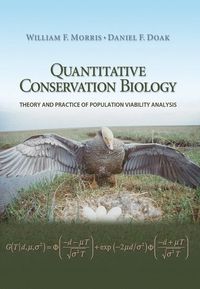
spara 20%
2 säljare
Quantitative Conservation Biology Upplaga 1
Published by Sinauer Associates, an imprint of Oxford University Press.
Conservation biology relies not only on the general concepts, but on the specific methods, of population ecology to both understand and predict the viability of rare and endangered species and to determine how best to manage these populations. The need to conduct quantitative analyses of viability and management has spawned the field of "population viability analysis," or PVA, which, in turn, has driven much of the recent development of useful and realistic population analysis and modeling in
ecology in general. However, despite calls for the increased use of PVA in real-world settingsdeveloping recovery plans for endangered species, for examplea misperception remains among field-oriented conservation biologists that PVA models can only be constructed and understood by a select group
of mathematical population ecologists.
Part of the reason for the ongoing gap between conservation practitioners and population modelers has been the lack of an easy-to-understand introduction to PVA for conservation biologists with little prior exposure to mathematical modeling as well as in-depth coverage of the underlying theory and its applications. Quantitative Conservation Biology fills this void through a unified presentation of the three major areas of PVA: count-based, demographic, and multi-site, or
metapopulation, models. The authors first present general concepts and approaches to viability assessment. Then, in sections addressing each of the three fields of PVA, they guide the reader from considerations for collection and analysis of data to model construction, analysis, and interpretation, progressing from simple
to complex approaches to answering PVA questions. Detailed case studies use data from real endangered species, and computer programs to perform all described analyses accompany the text.
The goal of this book is to provide practical, intelligible, and intuitive explanations of population modeling to empirical ecologists and conservation biologists. Modeling methods that do not require large amounts of data (typically unavailable for endangered species) are emphasized. As such, the book is appropriate for undergraduate and graduate students interested in quantitative conservation biology, managers charged with preserving endangered species, and, in short, for any conservation
biologist or ecologist seeking to better understand the analysis and modeling of population data.
Upplaga: 1a upplagan
Utgiven: 2002
ISBN: 9780878935468
Förlag: OUP USA
Format: Häftad
Språk: Engelska
Sidor: 480 st
Published by Sinauer Associates, an imprint of Oxford University Press.
Conservation biology relies not only on the general concepts, but on the specific methods, of population ecology to both understand and predict the viability of rare and endangered species and to determine how best to manage these populations. The need to conduct quantitative analyses of viability and management has spawned the field of "population viability analysis," or PVA, which, in turn, has driven much of the recent development of useful and realistic population analysis and modeling in
ecology in general. However, despite calls for the increased use of PVA in real-world settingsdeveloping recovery plans for endangered species, for examplea misperception remains among field-oriented conservation biologists that PVA models can only be constructed and understood by a select group
of mathematical population ecologists.
Part of the reason for the ongoing gap between conservation practitioners and population modelers has been the lack of an easy-to-understand introduction to PVA for conservation biologists with little prior exposure to mathematical modeling as well as in-depth coverage of the underlying theory and its applications. Quantitative Conservation Biology fills this void through a unified presentation of the three major areas of PVA: count-based, demographic, and multi-site, or
metapopulation, models. The authors first present general concepts and approaches to viability assessment. Then, in sections addressing each of the three fields of PVA, they guide the reader from considerations for collection and analysis of data to model construction, analysis, and interpretation, progressing from simple
to complex approaches to answering PVA questions. Detailed case studies use data from real endangered species, and computer programs to perform all described analyses accompany the text.
The goal of this book is to provide practical, intelligible, and intuitive explanations of population modeling to empirical ecologists and conservation biologists. Modeling methods that do not require large amounts of data (typically unavailable for endangered species) are emphasized. As such, the book is appropriate for undergraduate and graduate students interested in quantitative conservation biology, managers charged with preserving endangered species, and, in short, for any conservation
biologist or ecologist seeking to better understand the analysis and modeling of population data.
Begagnad bok
685 kr846 krSpara 161 kr (20%) mot nypris
Fri frakt & skickas inom 1-3 vardagar
Köpskydd med Studentapan
Varje köp täcks av Studentapans köpskydd som säkerställer att boken kommer fram, att du får rätt bok och att skicket stämmer överens med beskrivning.



